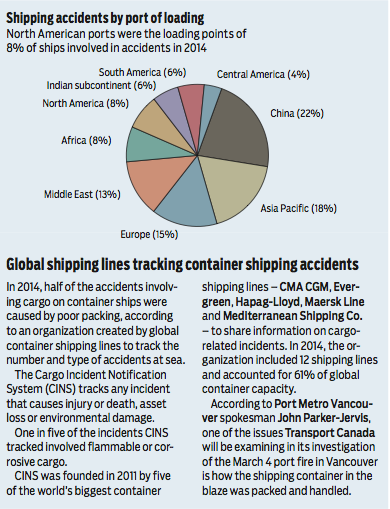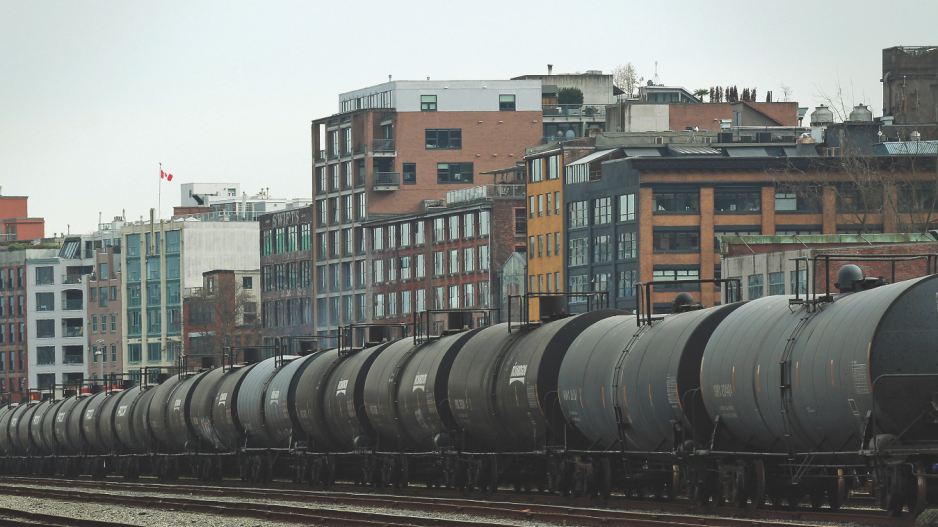As accidents involving chemicals go, Vancouver got lucky.
On the afternoon of March 4, a shipping container caught fire on the city’s waterfront. The container was full of a commonly used chemical called trichloroisocyanuric acid that had been shipped from China, according to Port Metro Vancouver.
As health officials warned that exposure to the smoke could cause breathing problems and eye irritation, the port was evacuated and city residents within a five-kilometre area in Vancouver’s east end were told to stay indoors, shut doors and windows and turn off air conditioners and furnaces.
The large plume of smoke wafted east and north to North Vancouver and Burnaby, causing concern in those communities as well. But by nightfall, the shelter-in-place advisory had been lifted and the fire was mostly under control.
It could have been worse, said Vancouver fire Chief John McKearney.
“We figured out it was a Class 1 oxidizer out of four classes of oxidizers,” McKearney said. “In the realm of oxidizers, it’s the least concerning. There are certainly other products that would have been more dangerous for us to concern ourselves with.”
Oxidizing liquids and solids are classified “based on their ability to cause spontaneous combustion and how much they can increase the burning rate,” according to the Canadian Centre for Occupational Heath and Safety. Class 1 oxidizers “slightly increase” the burning rate and do not cause spontaneous ignition with material that comes into contact with them, while Class 4 oxidizers can explode when exposed to slight heat or friction.
Vancouver Fire and Rescue Services and Transport Canada will now each complete a separate investigation into the incident.
For the City of Vancouver and Vancouver’s fire department, the incident is prompting questions about what is being shipped through the region and how prepared fire departments are to respond to a serious chemical spill or fire.
Along with other municipalities across Canada, Vancouver has been pushing for more information about dangerous goods from railways. But the March 4 fire shows the city may also need more information from Port Metro Vancouver, said deputy city manager Sadhu Johnston.
Following the Lac-Mégantic train derailment and explosion that killed 47 people in the summer of 2013, Transport Canada directed railways to give municipalities information about dangerous goods being shipped through communities.
The City of Vancouver receives confidential reports from Canadian National Railway (TSX:CNR) and Canadian Pacific Railway (TSX:CP), one year after the shipments have gone through. That’s not good enough, Johnston said.
“It’s supposed to be quarterly and we’re trying to get them on a regular basis,” Johnston said. “It’s not really happening the way it needs to happen.”
In emailed statements, CN and CP said they were complying with current regulations and continuing to work with local governments, including providing training to first responders.
Fire departments throughout the region also need more information about what is commonly being shipped and in what quantities, McKearney said. That’s information Vancouver Fire and Rescue currently doesn’t have.
During the March 4 fire, communication between Centerm terminal operator DP World, Port Metro Vancouver and the Vancouver fire department worked well: the fire department had information about the chemical in under 10 minutes, McKearney said. Firefighters also relied on Transport Canada’s Canutec emergency centre, which has chemical experts available around the clock.
But without more knowledge of the types and quantities of dangerous goods, first responders could be left without the right types of supplies – such as certain types of fire-suppressing foam or soda ash – or enough of them, McKearney said.
About a year ago, White Rock Mayor Wayne Baldwin was surprised to learn that railcars filled with Bakken formation crude oil, the same type of explosive cargo that caused the Lac-Mégantic disaster, were travelling through his community. The shipments were first noticed by an observant Crescent Beach resident who looked up markings on a railcar, Baldwin said.
Rail company Burlington Northern Sante Fe now gives White Rock information about shipments one month after they’ve gone through the city, Baldwin said. He and other residents have observed that train cars regularly contain cargo such as hydrochloric acid, ammonia hydroxide, chlorine, petroleum products and liquefied natural gas.
Baldwin would like his city to get advance notice before something dangerous, like 130 train cars of Bakken crude, travels through the community. 
Vancouver’s concerns about dangerous-goods movement extend to sea shipping.
In a submission to Transport Canada’s Tanker Safety Expert Panel in April 2014, the city said there is no system in place for “emergency preparedness, mitigation, response or recovery” for a fire, chemical or oil spill or other emergency originating on board a ship.
The City of Vancouver opposes Kinder Morgan’s proposal to expand its existing Trans Mountain pipeline, saying it will lead to a sharp increase in the number of oil-carrying tankers in the region’s waterways.
“[If] a tanker were to catch on fire, or a major toxic cloud were to come from that – what we experienced [on March 4] was absolutely minuscule compared to that kind of scenario,” Johnston said.
Fire departments in Metro Vancouver “don’t have anywhere near the resources to say we could mitigate that situation if it occurs,” McKearney said.
Vancouver’s port is an important part of the local, provincial and national economy, and dangerous goods will continue to be shipped through the city, Johnston said. While emergencies like the recent fire at the port are rare, the incident is a wake-up call for residents and business owners.
“How ready are [we] for an emergency and do we understand the risks of things that are being transported through our community?”
@jenstden




